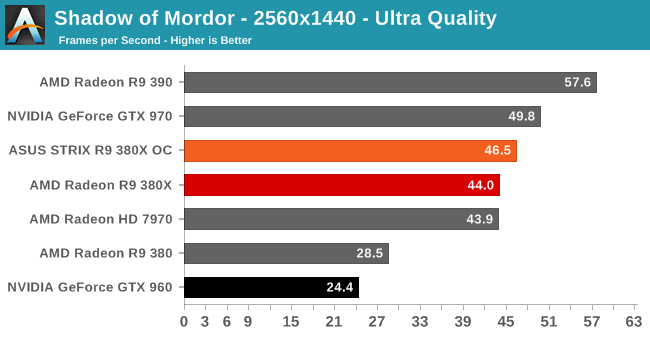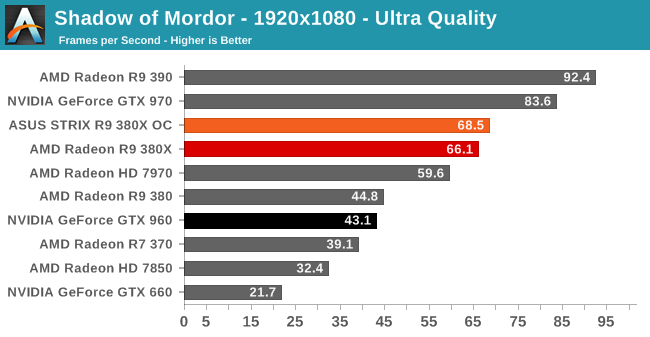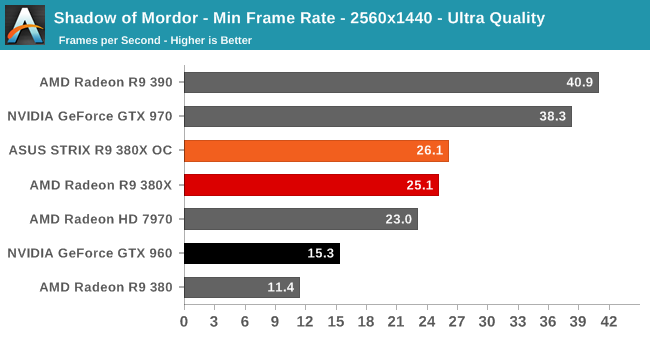The AMD Radeon R9 380X Review, Feat. ASUS STRIX
by Ryan Smith on November 23, 2015 8:30 AM EST- Posted in
- GPUs
- AMD
- Radeon
- Asus
- Radeon 300
Middle Earth: Shadow of Mordor
Our next benchmark is Monolith’s popular open-world action game, Middle Earth: Shadow of Mordor. One of our current-gen console multiplatform titles, Shadow of Mordor is plenty punishing on its own, and at Ultra settings it absolutely devours VRAM, showcasing the knock-on effect that current-gen consoles have on VRAM requirements.


Shadow of Mordor is the first game in our benchmark suite that really hammers memory capacity, which in turn drives a very large wedge between the 4GB R9 380X and the 2GB R9 380 and GTX 960. There’s simply no comparison here; even at 1080p the R9 380X is 50% or more ahead. And situations like this are a big reason that I believe that anything other than a budget card should come with 4GB at this time. Even if one is not buying an R9 380X, they should at least be buying a 4GB R9 380 or GTX 960.
Meanwhile it’s interesting to note that this is the only game that shows a real advantage for the R9 380X over the 7970. It’s possible that we’re looking at the differences in 3GB of memory versus 4GB, but given the results at 1440p versus 1080p, I suspect there’s a bit more going on here. Either way it shows that there will be times where a full Tonga card is a distinct improvement over a full Tahiti card.


Our minimum framerates reiterate what we saw in our averages. Even at 1080p the smaller 2GB cards get hit hard.










101 Comments
View All Comments
CaedenV - Monday, November 23, 2015 - link
Card idle so low now that it does not make much of a difference. Even leaving my 4 year old monster on 24/7 is costing me maybe $10-15/year, and with the improved idle power load on newer cards (I am running a 570), it would probably cut that in half.Not to say that you should go crazy and leave things on all of the time because it 'does not matter'... but unless you are running something with a 24/7 load like a render box or a server, then power costs is not a true consideration. Heat generation due to an inefficient card may be a consideration, but not the price of the power used.
rviswas - Monday, November 23, 2015 - link
i was gonna say difference between gtx 860 and this card is less than 5w at idle is says in the review itself look at power consumption.rviswas - Monday, November 23, 2015 - link
gts 960 I meanChaser - Monday, November 23, 2015 - link
Use your AMD GPU to help heat your home. Spoken like a true AMD apologist. LOLlooncraz - Monday, November 23, 2015 - link
Except he's running an nVidia card.Dribble - Monday, November 23, 2015 - link
Too close in price to the 970/390. Anyone spending that much will stretch the extra few $ for the much faster card. Price/performance isn't good enough - needs to be $200.Beany2013 - Tuesday, November 24, 2015 - link
Except when you literally can't afford those extra $ - IE in the UK, the 380X starts around £190, the 970 starts around £250 (using Overclockers.co.uk as a reference).The cost difference there, if all you're doing is upgrading a GPU, is significant enough where you can't really say 'ooh, it's only a little more' - if we were talking £190 and £220, that'd be different.
Likewise, if you're configuring a whole system, and aren't an *avid* gamer (IE, as a survey of one, I mostly dick about in Serious Sam 3 and Metro 2033/Last Light - both of which are far better with a chunky GPU if you like your shiny goodness) then the £60 difference is better spent elsewhere, like RAM, storage, or a larger monitor.
Horses for courses, but if you're trying to eke out as much overall value as possible for a machine without horribly compromising on performance, AMD make a hell of a lot of sense.
Me? I'm waiting for Fiji to come down below £200. And, you know, to get a new job. Which'd probably help, natch.
AndrewJacksonZA - Monday, November 23, 2015 - link
Re: "Finally, we’re also unable to include compute benchmarks for R9 380X at reference clocks, as AMD’s drivers do not honor underclocking options with OpenCL programs."Would someone please be so kind as to explain "underclocking options with OpenCL programs" to me please? Why do the cards need to be underclocked when running OpenCL programs?
Thank you.
Ryan Smith - Monday, November 23, 2015 - link
The card we received is the STRIX R9 380X OC, which comes with a factory overclock of 1030MHz, versus 970MHz for a reference card. We underclock this to get reference performance, however underclocking doesn't work with OpenCL programs.AndrewJacksonZA - Monday, November 23, 2015 - link
OK, got it, thanks Ryan.